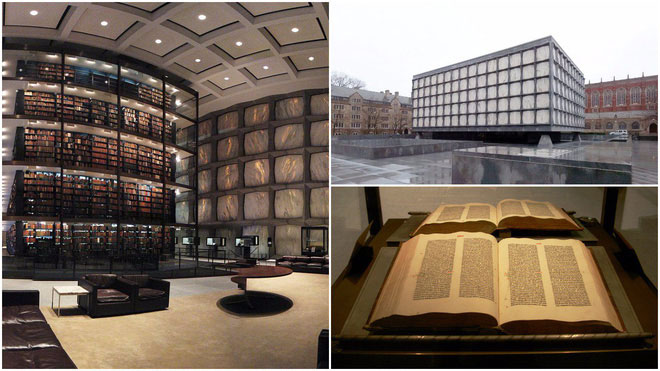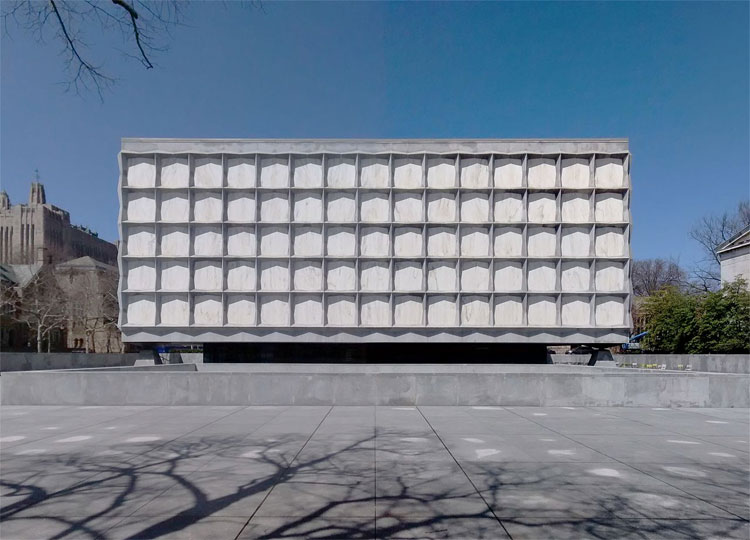The design of Yale University library helps protect old books from the sun
Future generations will have to bear great thanks to the architects who designed this project.
The library is a place for bookworms to immerse themselves in it, which is not controversial. For centuries, its role in society is extremely important for humanity's progress. It is extremely positive that there are many solid and unique libraries built, to preserve the invaluable achievements of inner knowledge for future generations.

Library of Manuscript Manuscripts and Beinecke Rare Books.
In ancient times, the Library of Alexandria was probably the most advanced library at the time, considered a "place of modern world". We can hardly imagine the great loss of such a library, considering all the efforts to build it and the rare titles it holds and preserves.
In today's modern world, it is unthinkable what our world would be without a 300-year-old Trinity University Library in Dublin, for example, where more than 200,000 books were kept, including the Gospel. Original Kells. We cannot imagine society without the historic Clementinum building in the Czech Republic, which is considered the most beautiful library in the world.
The same is true for the Handwritten Manuscript Library and the Beinecke Rare Book in the United States, known as the "gem box" or "Human Laboratory".

The outside of the library.
Built in 1963, this library belongs to Yale University , located in New Haven, Connecticut. On sunny days, its distinctive exterior design seems to have a floating feeling on the dark gate. This modern school architecture is home to rare and expensive books and literature, and was founded as a gift from the Beineck family . E. With self-funding, the library is financially independent of Yale, however, is still under joint administration with the school's library system, along with the Yale Federation.

Library on rainy day, this photo depicts 4 large pillars at the corners to support the house.
This 6-storey building is lifted up from the ground, surrounded by a square outer shell, and especially without a window. These walls are made entirely of translucent marble panels. They only let the dim light from the outside penetrate, ensuring the inner "treasures" are protected from direct sunlight.
At night, similar panels allow light from inside to leak out, turning the face of the building dyed with a brilliant amber color.
The outside dimensions of the building have a perfect mathematical ratio, which is 1: 2: 3 highly corresponding: wide: long. Inside the building, the interior is designed by renowned American architect Florence Knoll.

Beinecke's solid appearance and the addition of the Yale Law School's Gothic twist in the background
The public gallery is one of the features of the building, where visitors can see the library's most precious touches, and the rest of the Gutenberg Bible. This book began for the Gutenberg Revolution in Europe, marking the dawn of the era of printed books in the Western world.
One floor in the building is now a garden filled with Isamu Noguchi sculptures. There, the Pyramid represents time, the Sun is the disk, and the Cube represents change.

The courtyard in the New Classical Hewitt school surrounds Beinecke.
Today Beinecke is one of the largest buildings in the world dedicated to preserving books and signing rare copies. Particularly, the central court has kept up to 180,000 volumes, while more than 600,000 more are kept in underground tunnels. The entire Beinecke collection is estimated to be one million volumes, and many more million copies.

Beinecke's mezzanine interior.
The history of the library can be traced back to the late 19th century, as soon as the first copies of Yale University Library's rare and valuable books were carefully placed in other prices. each of the College Library, now known as Dwight Hall.
In 1918, the school received investments to design reading rooms for rare books, which were opened in 1930. Yale's English professor Chauncey Brewster Tinker is known for collecting a lot of massive works, along with many other Yale alumni.

Two rare editions of the original Gutenberg Bible.
By the end of the 1960s, this collection had names for 130,000 copies and even more copies. It was those who had made invaluable contributions to Yale at the time, Edwin and Frederick Beinecke as well as Johanna Weigle who laid the foundation for the unique library that we see today.
What the bookwriters can admire at the Beinecke Library today is truly mesmerizing. There is an amazing collection given by King George III , referred to as the King's Library, as well as precious collections of American and German literature.

A close-up view of rare books in the library building.
The Beinecke Library also became the home of many different collections, such as those published in Latin America in 1751 and North America in 1821, but that is only a small part of all hidden treasures. behind the walls of this building.
Along with the ancient papyrus books or the Middle Ages, scholars can completely access the handwritten copies of modern and modern authors. Just like other massive and majestic libraries in the world, it may take many lives together to read all the books that are not here.
That said, it is even an exaggeration. Just getting all those books out of the price also lost a lifetime.
- British Library digitized books
- Bullet bombs with a secret underground library in Syria
- The library of digital books in Europe was born
- Discover ancient books wrapped in human skin
- ISS International Space Station will have an electronic library
- He published the first online fossil library
- Librivox book library says
- The wonders of world heritage have disappeared forever
- National Library of Chile - Latin America's largest library
- Blood tests, know when you die
- 80-year-old scientist opens a library for free
- NASA opens the audio library for free
 Norway built the world's tallest wooden tower
Norway built the world's tallest wooden tower Kremlin
Kremlin Ashurbanipal: The oldest royal library in the world
Ashurbanipal: The oldest royal library in the world Decoding the thousand-year construction of Qin Shihuang shocked the world
Decoding the thousand-year construction of Qin Shihuang shocked the world